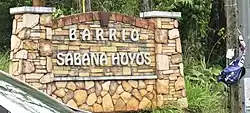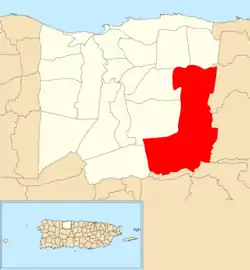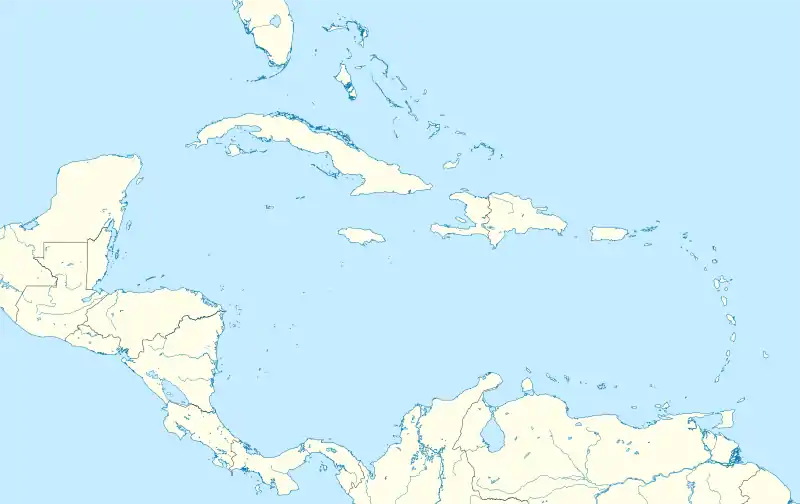Sabana Hoyos, Arecibo, Puerto Rico
Sabana Hoyos is a barrio in the municipality of Arecibo, Puerto Rico. Its population in 2010 was 10,745.[3][4][5]
Sabana Hoyos | |
|---|---|
Barrio | |
 Rock wall Sabana Hoyos sign | |
 Location of Sabana Hoyos within the municipality of Arecibo shown in red | |
 Sabana Hoyos Location of Puerto Rico | |
| Coordinates: 18°22′37″N 66°36′43″W[1] | |
| Commonwealth | |
| Municipality | |
| Area | |
| • Total | 23.02 sq mi (59.6 km2) |
| • Land | 23.00 sq mi (59.6 km2) |
| • Water | 0.02 sq mi (0.05 km2) |
| Elevation | 751 ft (229 m) |
| Population (2010) | |
| • Total | 10,745 |
| • Density | 467.2/sq mi (180.4/km2) |
| Source: 2010 Census | |
| Time zone | UTC−4 (AST) |
Sabana Hoyos is the largest barrio of Puerto Rico.[6]
History
Puerto Rico was ceded by Spain in the aftermath of the Spanish–American War under the terms of the Treaty of Paris of 1898 and became an unincorporated territory of the United States. In 1899, the United States conducted its first census of Puerto Rico finding that the population of Sabana Hoyos barrio was 3,568.[7]
| Historical population | |||
|---|---|---|---|
| Census | Pop. | %± | |
| 1980 | 7,570 | — | |
| 1990 | 9,440 | 24.7% | |
| 2000 | 11,064 | 17.2% | |
| 2010 | 10,745 | −2.9% | |
| U.S. Decennial Census[8] 1899 (shown as 1900)[9] 1910-1930[10] 1930-1950[11] 1980-2000[12] 2010[13] | |||
Sectors
Barrios (which are roughly comparable to minor civil divisions)[14] in turn are further subdivided into smaller local populated place areas/units called sectores (sectors in English). The types of sectores may vary, from normally sector to urbanización to reparto to barriada to residencial, among others.[15][16][17]
The following sectors are in Sabana Hoyos barrio:[18][19]
Calle Las Brisas, Comunidad Moreda, Comunidad Nuevas Sabana Hoyos, Hacienda San José, Reparto Los Rosario, Sector Aldea, Sector Alianza, Sector Allende, Sector Asomante, Sector Ballajá, Sector Candelaria, Sector Carolina, Sector Comisión, Sector Córdova, Sector Fortuna, Sector Hacienda Las Abras, Sector Jovales, Sector La Alianza, Sector La Vega, Sector Las Arenas, Sector Las Correa, Sector Loma Correa, Sector Manantiales, Sector Méndez, Sector Montaña, Sector Riachuelo, Sector Román, Sector Segunda Unidad, Sector Villa Ferré, Sector Walcott, Urbanización Brisas de Manantiales, Urbanización Estancias de la Sabana, Urbanización Estancias Palma Real, Urbanización Flamboyanes, Urbanización Hacienda San Agustín, Urbanización Jardines de Candelaria, Urbanización Manantiales, Urbanización Mansiones de Manantiales, Urbanización Reparto Manantiales, Urbanización Reparto Santa María, Urbanización Reparto Vista Verde, Urbanización Sabana Gardens, Urbanización Sabana I, and Urbanización Villa Fortuna.
References
- "US Gazetteer 2019". US Census. US Government.
- U.S. Geological Survey Geographic Names Information System: Sabana Hoyos barrio
- Picó, Rafael; Buitrago de Santiago, Zayda; Berrios, Hector H. Nueva geografía de Puerto Rico: física, económica, y social, por Rafael Picó. Con la colaboración de Zayda Buitrago de Santiago y Héctor H. Berrios. San Juan Editorial Universitaria, Universidad de Puerto Rico,1969.
- Gwillim Law (20 May 2015). Administrative Subdivisions of Countries: A Comprehensive World Reference, 1900 through 1998. McFarland. p. 300. ISBN 978-1-4766-0447-3. Retrieved 25 December 2018.
- Puerto Rico:2010:population and housing unit counts.pdf (PDF). U.S. Dept. of Commerce, Economics and Statistics Administration, U.S. Census Bureau. 2010.
- Santiago, Manuel (January 31, 2019). "Arecibo Asume El Alquiler De Cuartel De La Policía En El Barrio Sabana Hoyos". Isla news PR (in Spanish).
- Joseph Prentiss Sanger; Henry Gannett; Walter Francis Willcox (1900). Informe sobre el censo de Puerto Rico, 1899, United States. War Dept. Porto Rico Census Office (in Spanish). Imprenta del gobierno. p. 160.
- "U.S. Decennial Census". United States Census Bureau. Archived from the original on February 13, 2020. Retrieved September 21, 2017.
- "Report of the Census of Porto Rico 1899". War Department Office Director Census of Porto Rico. Archived from the original on July 16, 2017. Retrieved September 21, 2017.
- "Table 3-Population of Municipalities: 1930 1920 and 1910" (PDF). United States Census Bureau. Archived (PDF) from the original on August 17, 2017. Retrieved September 21, 2017.
- "Table 4-Area and Population of Municipalities Urban and Rural: 1930 to 1950" (PDF). United States Census Bureau. Archived (PDF) from the original on August 30, 2015. Retrieved September 21, 2014.
- "Table 2 Population and Housing Units: 1960 to 2000" (PDF). United States Census Bureau. Archived (PDF) from the original on July 24, 2017. Retrieved September 21, 2017.
- Puerto Rico:2010:population and housing unit counts.pdf (PDF). U.S. Dept. of Commerce Economics and Statistics Administration U.S. Census Bureau. 2010. Archived (PDF) from the original on 2017-02-20. Retrieved 2019-08-02.
- "US Census Barrio-Pueblo definition". factfinder.com. US Census. Archived from the original on 13 May 2017. Retrieved 5 January 2019.
- "Agencia: Oficina del Coordinador General para el Financiamiento Socioeconómico y la Autogestión (Proposed 2016 Budget)". Puerto Rico Budgets (in Spanish). Retrieved 28 June 2019.
- Rivera Quintero, Marcia (2014), El vuelo de la esperanza: Proyecto de las Comunidades Especiales Puerto Rico, 1997-2004 (first ed.), San Juan, Puerto Rico Fundación Sila M. Calderón, ISBN 978-0-9820806-1-0
- "Leyes del 2001". Lex Juris Puerto Rico (in Spanish). Retrieved 24 June 2020.
- "PRECINTO ELECTORAL ARECIBO 026" (PDF). Comisión Estatal de Elecciones (in Spanish). PR Government. 19 October 2018. Retrieved 2 August 2020.
- "PRECINTO ELECTORAL ARECIBO 027" (PDF). Comisión Estatal de Elecciones (in Spanish). PR Government. 8 October 2019. Retrieved 2 August 2020.